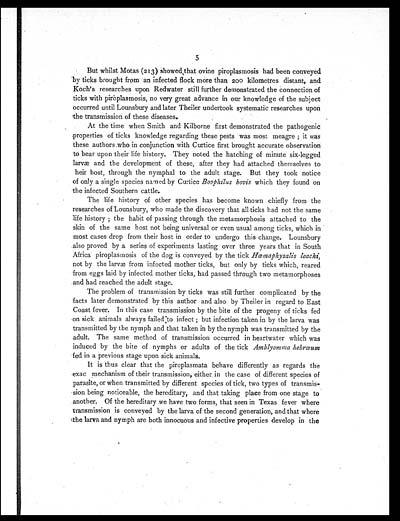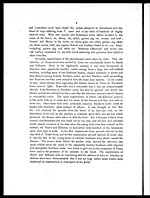Medicine - Institutions > Army health reports and medical documents > Scientific memoirs by officers of the Medical and Sanitary Departments of the Government of India > Number 29 - Piroplasma canis and its life cycle in the tick > Page i - Introduction
(13) Page 5
Download files
Individual page:
Thumbnail gallery: Grid view | List view

5
But whilst Motas (213) showed that ovine piroplasmosis had been conveyed
by ticks brought from an infected flock more than 200 kilometres distant, and
Koch's researches upon Redwater still further demonstrated the connection of
ticks with piroplasmosis, no very great advance in our knowledge of the subject
occurred until Lounsbury and later Theiler undertook systematic researches upon
the transmission of these diseases.
At the time when Smith and Kilborne first demonstrated the pathogenic
properties of ticks knowledge regarding these pests was most meagre; it was
these authors who in conjunction with Curtice first brought accurate observation
to bear upon their life history. They noted the hatching of minute six-legged
larvæ and the development of these, after they had attached themselves to
heir host, through the nymphal to the adult stage. But they took notice
of only a single species named by Curtice Boophilus bovis which they found on
the infected Southern cattle.
The life history of other species has become known chiefly from the
researches of Lounsbury, who made the discovery that all ticks had not the same
life history; the habit of passing through the metamorphosis attached to the
skin of the same host not being universal or even usual among ticks, which in
most cases drop from their host in order to undergo this change. Lounsbury
also proved by a series of experiments lasting over three years that in South
Africa piroplasmosis of the dog is conveyed by the tick Hæmaphysalis leachi,
not by the larvæ from infected mother ticks, but only by ticks which, reared
from eggs laid by infected mother ticks, had passed through two metamorphoses
and had reached the adult stage.
The problem of transmission by ticks was still further complicated by the
facts later demonstrated by this author and also by Theiler in regard to East
Coast fever. In this case transmission by the bite of the progeny of ticks fed
on sick animals always failed to infect; but infection taken in by the larva was
transmitted by the nymph and that taken in by the nymph was transmitted by the
adult. The same method of transmission occurred in heartwater which was
induced by the bite of nymphs or adults of the tick Amblyomma hebrœum
fed in a previous stage upon sick animals.
It is thus clear that the piroplasmata behave differently as regards the
exac mechanism of their transmission, either in the case of different species of
parasite, or when transmitted by different species of tick, two types of transmis-
sion being noticeable, the hereditary, and that taking place from one stage to
another. Of the hereditary we have two forms, that seen in Texas fever where
transmission is conveyed by the larva of the second generation, and that where
the larva and nymph are both innocuous and infective properties develop in the
Set display mode to: Large image | Zoom image | Transcription
Images and transcriptions on this page, including medium image downloads, may be used under the Creative Commons Attribution 4.0 International Licence unless otherwise stated. ![]()
| Permanent URL | https://digital.nls.uk/75030964 |
|---|
| Shelfmark | IP/QB.10 |
|---|---|
| Additional NLS resources: | |




